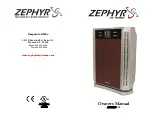
55
Fig. 75 — T-56 Internal Connections
Fig. 76 — RTU Open T-56 Sensor Connections
Connect T- 59
— The T-59 space sensor requires a separate, iso-
lated power supply of 24 VAC. See Fig. 77 for internal connec-
tions at the T-59. Connect the SEN terminal (BLU) to the RTU
Open controller at J20-1. Connect the COM terminal (BRN) to
J20-2. Connect the SET terminal (STO or BLK) to J20-3. See
Fig. 77.
Fig. 77 — Space Temperature Sensor Typical Wiring
(33ZCT59SPT)
Indoor Air Quality (CO
2
) Sensor — The indoor air quality sen-
sor accessory monitors space carbon dioxide (CO
2
) levels. This in-
formation is used to monitor IAQ levels. Several types of sensors
are available, for wall mounting in the space or in return duct, with
and without LCD display, and in combination with space tempera-
ture sensors. Sensors use infrared technology to measure the levels
of CO
2
present in the space air.
The CO
2
sensors are all factory set for a range of 0 to
2000 ppm and a linear mA output of 4 to 20. Refer to the instruc-
tions supplied with the CO
2
sensor for electrical requirements and
terminal locations. See Fig. 79 for typical CO
2
sensor wiring
schematic.
Fig. 78 — Indoor/Outdoor Air Quality (CO
2
) Sensor
(33ZCSENCO2) — Typical Wiring Diagram
To accurately monitor the quality of the air in the conditioned
air space, locate the sensor near a return-air grille (if present) so it
senses the concentration of CO
2
leaving the space. The sensor
should be mounted in a location to avoid direct breath contact.
Do not mount the IAQ sensor in drafty areas such as near sup-
ply ducts, open windows, fans, or over heat sources. Allow at least
3 ft (0.9 m) between the sensor and any corner. Avoid mounting
the sensor where it is influenced by the supply air; the sensor gives
inaccurate readings if the supply air is blown directly onto the sen-
sor or if the supply air does not have a chance to mix with the
room air before it is drawn into the return airstream.
Wiring the Indoor Air Quality Sensor
— For each sensor, use
two 2-conductor 18 AWG (American Wire Gage) twisted-pair ca-
bles (unshielded) to connect the separate isolated 24 vac power
source to the sensor and to connect the sensor to the control board
terminals.
To connect the sensor to the control, identify the positive (4 to
20 mA) and ground (SIG COM) terminals on the sensor. See Fig.
78. Connect the 4-20 mA terminal to the RTU Open controller at
J4-2 and connect the SIG COM terminal to RTU Open J4-3. See
Fig. 79 — RTU Open/Indoor CO
2
Sensor (33ZCSENCO2)
Connections
2
3
4
5
6
1
S
W1
S
EN
S
ET
Cool
Warm
BRN (GND)
BLU (
S
PT)
RED(+)
WHT(GND)
BLK(-)
CCN COM
S
EN
S
OR WIRING
JUMPER
TERMINAL
S
A
S
S
HOWN
BLK
(T56)
S
EN
J20-1
J20-2
S
EN
S
ET
J
u
mper
J20-
3
S
ET
OR
SET
SEN
OPB
COM- PWR+
BLU (SPT)
BLK (STO)
24 VAC
SENSOR
WIRING
POWER
WIRING
BRN (COM)
NOTE: Must use a separate isolated transformer.
J20-3
J20-2
J20-1
8
7 6 5 4
3
2 1
2 1
H G 24 VAC
OR
24 VDC
NC
ALARM
RELAY
CONTACT
S
COM
NO
}
0-10VDC
S
IG COM
4-20mA
+
+
-
+ -
J
3
J4
S
EN
COM
J4-2
J4-
3
IAQ
S
en
s
or
24 VAC
Summary of Contents for 580J*16D Series
Page 4: ...4 Fig 2 Unit Dimensional Drawing Sizes 08 09 and 12 ...
Page 5: ...5 Fig 2 Unit Dimensional Drawing Sizes 08 09 and 12 cont ...
Page 6: ...6 Fig 3 Unit Dimensional Drawing Size 14 ...
Page 7: ...7 Fig 3 Unit Dimensional Drawing Size 14 cont ...
Page 8: ...8 Fig 4 Unit Dimensional Drawing Size 16 ...
Page 9: ...9 Fig 4 Unit Dimensional Drawing Size 16 cont ...
Page 15: ...15 Fig 9 580J 16 Roof Curb Details ...
Page 32: ...32 Fig 58 580J 08 14 Typical Perfect Humidity Dehumidification System Humidistat Wiring ...
Page 33: ...33 Fig 59 580J 16 Typical Perfect Humidity Dehumidification System Humidistat Wiring ...
Page 48: ...48 Fig 67 580J 08 12N P Typical RTU Open System Control Wiring Diagram ...
Page 49: ...49 Fig 68 580J 08 14 Typical RTU Open System Control Wiring Diagram ...
Page 50: ...50 Fig 69 580J 16 Typical RTU Open System Control Wiring Diagram ...
Page 52: ...52 Fig 71 580J 16 Typical RTU Open System Control Wiring Diagram with Perfect Humidity System ...










































